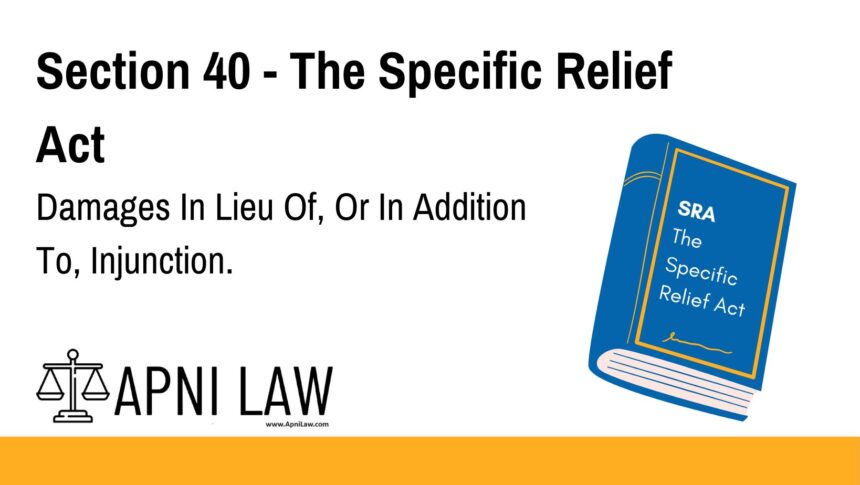Code: Section 40 – The Specific Relief Act, 1963
(1) The plaintiff in a suit for perpetual injunction under Section 38, or mandatory injunction under Section 39, may claim damages either in addition to, or in substitution for, such injunction, and the court may, if it thinks fit, award such damages.
(2) No relief for damages shall be granted under this section unless the plaintiff has claimed such relief in his plaint:
Provided that where no such damages have been claimed in the plaint, the court shall, at any stage of the proceedings, allow the plaintiff to amend the plaint on such terms as may be just for including such claim.
(3) The dismissal of a suit to prevent the breach of an obligation existing in favour of the plaintiff shall bar his right to sue for damages for such breach.
Explanation of Section 40 – Damages in Injunction Cases
Section 40 of the Specific Relief Act allows a plaintiff to seek compensation (damages) along with, or instead of, an injunction. This section applies to cases where a person seeks a perpetual injunction (under Section 38) or a mandatory injunction (under Section 39).
Here’s what it means:
- A person filing a suit for an injunction can also ask for monetary damages.
- The court has the discretion to grant these damages if it believes it is fair.
- However, damages can only be awarded if they are explicitly claimed in the initial legal complaint (plaint).
- If the damages weren’t included earlier, the plaintiff can amend the plaint with the court’s permission.
- But if the injunction is denied, the person cannot file a separate lawsuit later to recover damages for the same issue.
This section ensures that plaintiffs have one clear opportunity to seek both preventive and compensatory relief. It encourages them to present a complete case from the beginning.
Illustration
Example 1: Damages with Perpetual Injunction
A factory constantly emits pollutants onto a neighboring property. The neighbor files a suit for a perpetual injunction to stop the pollution and also asks for damages to cover the cost of cleaning and health expenses. The court, considering both aspects, grants the injunction and awards damages.
Example 2: Injunction Refused, No Damages Allowed Later
A person sues to stop construction that allegedly blocks sunlight to their home but doesn’t claim damages. The court dismisses the case. Later, the person tries to file a separate lawsuit for damages. Under Section 40(3), this second claim is barred.
Common Questions and Answers on Section 40 – Specific Relief Act
1. Can I get damages and an injunction at the same time?
Yes. Section 40 allows you to claim both in the same suit. The court may grant either or both, based on the facts.
2. Do I need to ask for damages in my original suit?
Yes. You must include a claim for damages in your original plaint. If you forget, the court may allow you to amend it.
3. What happens if the court denies my request for an injunction?
If the injunction is refused and you haven’t asked for damages in the same suit, you cannot later file a separate claim for damages for the same issue.
4. Who decides whether damages are granted?
The court has full discretion. It will look at the facts and decide whether damages should be awarded, and in what amount.
5. Is this section only for permanent injunctions?
Yes. Section 40 specifically applies to perpetual injunctions under Section 38 and mandatory injunctions under Section 39.
Conclusion
Section 40 of the Specific Relief Act gives flexibility to people seeking legal protection. It allows them to combine their claim for injunction with a request for damages. However, it places a responsibility on the plaintiff to claim all necessary reliefs in the initial suit. Failing to do so may result in losing the chance to seek compensation later.
For more legal insights and plain-language explanations, visit ApniLaw.








